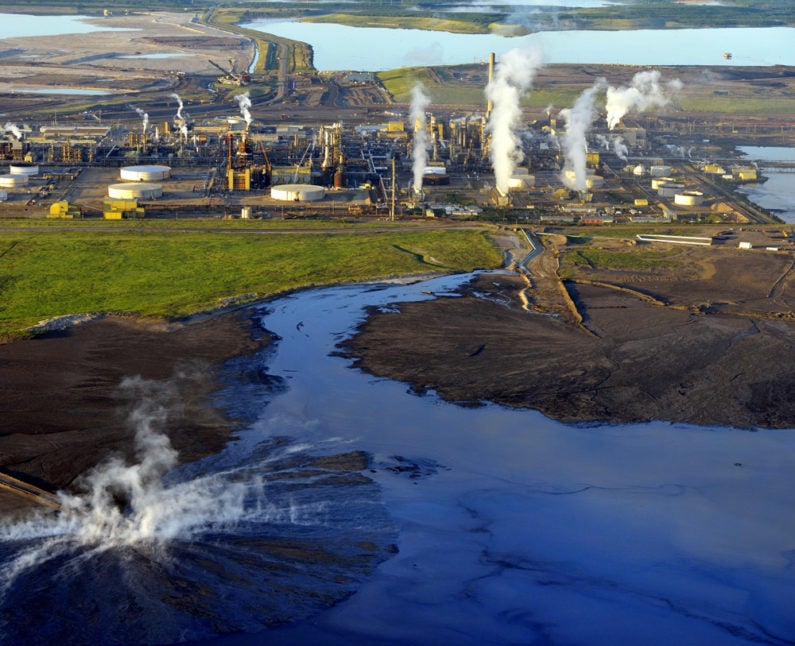Unexamined risks from tar sands oil may threaten oceans
A lack of publicly available information about the chemical composition of fuel mined from tar sands hampers efforts to safeguard marine habitats. A new analysis recommends that officials gain a better understanding of the fuel’s environmental impacts before setting regulations.
As President-elect Donald Trump prepares to overhaul energy and environmental regulations, a troubling question hangs over an emerging source of unconventional oil Trump has indicated he wants to expand. Bitumen – a tar-like fuel extracted from oil sands in Canada and elsewhere – is often stored in coastal areas and transported by ship. So, what are its potential effects on valuable ocean environments?

The Athabasca oil sands in northeastern Alberta, Canada, are a major producer of heavy crude oil. (Image credit: Michael Collier)
The short answer, according to a study published Dec. 20 in Frontiers in Ecology and the Environment, is: we have no idea. The study recommends collecting more information about the possible environmental effects of bitumen before making regulatory decisions.
Although a great deal of research has focused on the effects of conventional oil spills, little information exists about potential impacts from spills of unconventional oil derived from the bitumen extracted from oil sands. Diluted bitumen is chemically distinct from conventional oil, and its composition varies according to the chemicals used to make the viscous material flow. Because manufacturers are not required to fully report the makeup of these chemical mixtures, little is known about bitumen products’ effects on marine life and food chains.
“There just isn’t enough science in the public eye to answer questions about the risk bitumen poses to the ocean,” said study lead author Stephanie Green, a Banting postdoctoral fellow in the Center for Ocean Solutions at Stanford University. “We found almost no research about bitumen’s effects on marine species.”
These knowledge gaps make it impossible to create effective policies on oil sands development, transport and disaster response in the ocean. These issues are at the center of energy and environmental policy debate in Canada, America’s key source of oil sands products. Canada’s federal government recently approved expanding transport of diluted bitumen from inland deposits to the Pacific coast via pipeline.
“In this context, policymakers risk confusing the lack of evidence for particular environmental effects with evidence that there is no risk,” Green said.
The first-of-its-kind global analysis considered the footprint of existing and proposed oil sands developments and coastal transport routes, to reveal 15 different types of stress to ocean environments. These stresses range from oil spills and ship-animal collisions to ocean acidification and temperature increases caused by climate change, with oil sands products contributing more greenhouse gas per barrel than light crude oil throughout its lifecycle. In addition to noting the lack of information on many of these impacts, Green and colleagues concluded that many of these stresses are overlapping. Up to 10 of the 15 impact pathways co-occur within the footprint of proposed coastal tanker routes, but there are few scientific studies examining the effect of two or more impacts arising simultaneously.
“The gaps in scientific understanding we identified cast doubt on claims that risks can be effectively managed or mitigated,” said co-author Wendy Palen of Simon Fraser University. “Projects should not be considered in isolation, and multiple types of impacts need to be considered simultaneously. Everything is connected.”
To rectify the situation, the study’s authors recommend using a framework that can assess the consequences of multiple environmental impacts and their cumulative effects, including the ultimate fate of the petroleum products in the atmosphere. The authors urge scientists, governments, and industry to work together to fill information gaps so that the risks of such projects are known ahead of regulatory decisions in the United States and Canada.
“The findings in our paper are part of a broader effort by independent scientists to pull together what is known from various fields of research to inform sound decisions about energy and environmental policy,” said co-author Thomas Sisk of Northern Arizona University.
The Center for Ocean Solutions is an interdisciplinary center for ocean science, policy, and law at Stanford, in partnership with the Monterey Bay Aquarium and Monterey Bay Aquarium Research Institute.
Co-authors of “Oil sands and the marine environment: current knowledge and future challenges” include researchers at Simon Fraser University, Oregon State University, Northern Arizona University, and the Hakai Institute.
